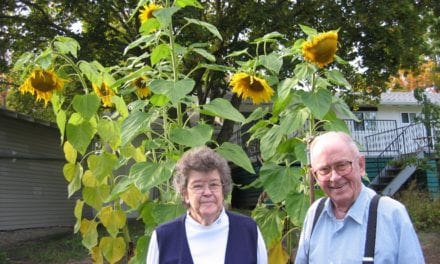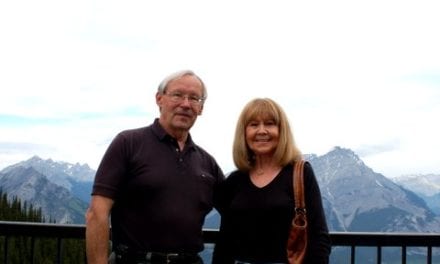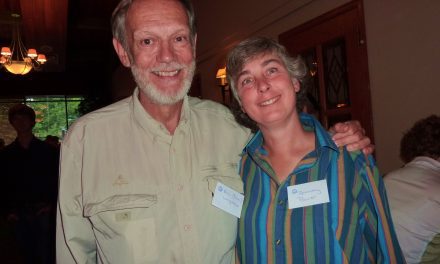Rod: I understand that there was some concern from Fisheries about that.
Larry: Yes, Fisheries & Oceans. Of course we have to get into the creek bed somewhat in order to put the berm back where it is. Now it’s taken the southwest corner right out of the campground and that area had some of the nicest camping spots. We were close to an agreement (with Fisheries & Oceans) and unfortunately, the fellow we were dealing with passed away and now the newer people that come on board won’t even talk to us about changing waterways. It’s ancient waterways and they worry about the bull trout but you can’t get up the stream there now so if we built something better it would be beneficial to the trout as well.
Dale: The water is not above the ground at some times of the year down there at that south end.
Rod: Really, it is an alluvial fan.
Larry: It is. And that is their (Fisheries & Oceans) argument. (They say) “You can’t fight nature so stay away from it!”
Clarence: I talked to (a fellow from) Alberta Environment one time about going into the creek and he said the creek was higher than the campground so he said you know you can’t do anything with something like that.
Larry: The 2013 flood clogged the whole lower part of the alluvial fan and its normal (stream) bed and the water ran through the lower part of the campground over the road to the east and back into the river. We made some changes there and built a bit of a berm but that is not going to stand up to any future floods.
Dale: I think if we don’t get allowed to put something up there and they don’t let us do a lot of things, (eventually) there won’t be a campground there. It won’t stand up to the weather we have lately if we aren’t allowed to do something to protect the campground against Mother Nature. We will lose it!
Rod: There should be some sort of acknowledgement that you need some sort of long-term solution (to the flooding problem) because it will be a constant problem and as you say, it degrades it each time.
Clarence: In 1994 when we started the agreement with Parks Canada it was indicated that it was a problem and would always be a problem. We built up that berm a little bit all the time and got the water to go down that creek bed to keep it out of the campground. However, the last number of years it has been going into the campground.
Dale: After that last flood in 2013 they wouldn’t let us put anything more onto the berm.
Larry: In 2011 we rebuilt the berm again, with mostly volunteer help. (Clarence: FOESA built a small berm on the creek bank starting in I believe 2005 and did maintenance on it every year including 2010. Maintenance was adding pit run to areas that was worn down from water or foot and horse traffic. 2008 was a major storm as a few other years and all we did was repair the washed out areas and this was not a major job. This worked fairly well with limited water in the campground and hardly any ice build up over winter. This was done under direction of long-term board members. In February 2011 nine board members resigned including myself. It was totally washed out in 2009. It was rebuilt in 2011 with consultation from Parks Canada, who advised where it should be placed. This berm washed out in 2013 and remains that way today, with some of the campground not usable due to water.) It was a good sizeable berm that went right down through there. One of the big purposes of the berm was to stop the ice from inundating the whole campground because it would take until well into June sometimes for the ice to melt off. And so, that would help keep the ice back, and also prevent any significant amount of flooding that might occur. But (the flood of) 2013 took the berm right out.
Clarence: When we first built that berm and continued to build it up (when necessary), the water went to the west. We made sure we did this work in the fall. (As a result) there was hardly any water or ice getting into the campground.
Dale: Yeah, it worked well.
Clarence: But, you have to continue to do it.
Dale: And we were going to continue but they (Parks Canada Agency and Fisheries & Oceans) put a stop to us.
Marie: I’ve heard some talk of possibly expanding the Bighorn Campground to the east.
Larry: That is in the works. The plan for the expansion of the campground is tied directly to the project of building a new road into the ranch. Unfortunately, those two things got lumped together and on the Archaeological Assessment for the road they found archaeological evidence that would not allow them to build the road (on the site) where it was originally designated. So it was back to stage one and that’s where it is at now. I talked with Rick & Jean just a week ago about that and they think Parks may have got a plan now for the road location.
Rod: It seems to be under constant delay.
Larry: Once they get the Archaeological Assessment, then they need an Engineer’s approval so that seems to be where they are at now. That would have been our big summer project this year, to work on the new (campground) expansion. We told Parks Canada that we could handle it ourselves.
Dale: We don’t need any financial help whatsoever.
Larry: But they said that Parks Canada will have equipment on site and that they want to help. Our view was to keep Parks Canada’s involvement at a minimum so that they have less of a claim that it’s theirs, or whatever, in the future. You can see what Clarence has done in the past and our group is still very strong and active. We just need to talk to the right people and we can have all kinds of equipment and volunteers out there to build the trails and roads or access.
Rod: There needs to be a little common sense there….when you think about it, the whole ranch is an archaeological site…..right?
Larry: Yes, I guess no matter where you look you are going to find an arrowhead or something.
Dale: Our membership should have a little bit of influence. It has grown to over 700 family members. That is quite an accomplishment. You have got to pat Clarence on the back for the whole thing because without the work that he put into the ground with FOESA to start with, the organization would not where it is today.
Larry: Pretty strong roots.
Marie: Yeah, you’ve always had a pretty strong group of keen, dedicated volunteers.
Larry: Yeah, it’s been a pretty good solid group all along.
Rod: That whole effort does not go unnoticed. The long-term objective is something that has been established by a great working effort on your part. It would be pretty hard for Parks to complain about the effort, financial investment, and volunteer time you have put into the making it work.
Clarence: A lot of the gravel we put in there is now in Sundre! (everyone laughs!)
Larry: Or Saskatchewan!
Rod: I know that all equestrian users throughout the province, members or not, who use that facility certainly appreciate your efforts in regards to the Bighorn Campground.
Clarence: Talking about funding support to FOESA, the Bowden Light Horse Association started funding us (in abut 1994) when we first started and they held a casino and I think it was half the proceeds went to FOESA. We would supply manpower to them for the casino. This happened for a few years. We also got a lot of manpower support from them too. And the Calgary Regional Trail Riders gave us quite a bit of money for a number of years.
Dale: They still do give us donations.
Larry: The Alberta Trail Riders, a group out of Edmonton, also donate to FOESA. Also, the Lacombe Light Horse Association has been coming on board the last couple of years. So, we are certainly the umbrella group being recognized.
Dale: There is a donkey and mule club also who support us.
Larry: We need to look at expansion there. During the weekend of July 23rd (not a long weekend) you could not find a square foot of space in the Bighorn Campground to set up out there. Rick said they counted at least 187 horses on the Saturday night in that campground. There is more and more use all of the time.
Clarence: (referring to documentation) In May of 1994 Lands and Forests counted 300 or 350 horses there on the long weekend in May (in those years) so even back then it was heavily used.
Larry: Long weekends can have up to 300 horses or more.
Rod: On the busy weekends do you direct people where to camp?
Dale: You can’t. It’s a random camping thing – first come first served. Who is going to have the authority to say who can camp where? When the space runs out it runs out; and hopefully we don’t have too many “rifle” problems. (laughs)
Larry: We just received a complaint. Our website crashed about 6 months ago and we finally got it up and running again (www.foesa.org). A lady sent in a concern stating that they had arrived about 10 o’clock at night and tried to find a place to camp. Her complaint was that there were camper trailers parked right next to horse stalls and these campers had no horses. And so, you know, there again, we are not policing this. We are putting out a note on the website and we will send it out in an email to our members just asking people if you are going to camp there and if you don’t have horses please leave the stalls available for people with horses.
Clarence: There are also people who “reserve” stalls by putting one or two horses in don’t allow anybody else to put horses in. They will say that they have friends coming.
Rod: Rick had mentioned that the last few years there have been more and more people camping without horses. They are hiking and then there are maybe the mountain bikers and other people who want to use the area.
Larry: Is it even legal for them to ride a mountain bike out there?
Marie: They could ride a mountain bike on the former Cascade Fire Road to the Banff park boundary and on the ranch itself. When we were at the ranch there were restrictions on horse-drawn wagons and motorized vehicles. Tim Barton was the only one who had permission to cross the ranch with a horse-drawn wagon. I am not sure if those restrictions are still in place or if they have relaxed that.
Larry: I think that the users (of the campground) are more consistent now.
Rod: What do you see there for the future? You mentioned that the capacity is pretty much close to being reached at certain times. Also there are other users that have to be somewhat accommodated unless they (Parks Canada) make provisions not to allow other types of users. There are all kinds of different ways you could try to handle that. You mentioned frustrations having non-horse users among horse parties. We all know that mountain bikes generate certain problems with horses, especially in a confined area.
Dale: They haven’t been a problem.
Clarence: At some of our first meetings we had hikers and bikers in attendance. They were upset that upon going to the campground there was horse manure around and on the trails and stuff like that. I never heard those problems expressed much after that. But in the earlier years we did.
Marie: With the horse club in Banff that John and I belonged to for many years. The two groups (equestrians and mountain bikers) worked together to establish trail etiquette on shared trails. There was the rare incident that usually involved a speed issue on the part of the mountain biker.
Rod: At some time down the road FOESA might have to consider that kind of a restriction. This is the only major equestrian area in that location.
Marie: The thing with the mountain bikes is that they can only go to the park boundary. So they are very restricted. It is the same with the quads. They can go to Eagle Lake and that is not a very exciting trip for the avid quad rider. For someone like Johnny and I, or a family just riding a quad up to the lake for a picnic that short ride would be sufficient. I think for the mountain bikes, they really can’t go very far at the ranch. I don’t see it as a huge attraction for cyclists but I can foresee that some families might bring bikes so that some of the family ride horses while the rest of their family group rides their mountain bikes elsewhere for a short ride.
Rod: If there is a push for expansion (of the campground) maybe this is one avenue FOESA might want to consider – to separate the hikers from the horses by having a designated area for non-equestrians for example.
Larry: That little open area in the very southwest corner where the river comes in – the 2013 flood cut that area in half, so now we have kind of designated that for ‘trailers only’ for this year. That used to be the panel area for horses and they have got that worked up so well there is not a damn bit of grass growing anymore. So we thought we’d get the horses out of there for a few years and see if that will kind of come back. So, that is one area that would accommodate non-horse campers. Everybody wants to use panels now and that is a pain in the ass because they have just destroyed the ground underneath where the panels are set. The horses are moving constantly.
Marie: Johnny, when he was the Ranch Manager, was not in favour of panels for that very reason. However, Parks Canada allowed the use of panels after we left the ranch.
Larry: The crowding we are experiencing now relates to the fact that we have probably lost about one-eighth of our camping space due to that 2013 flood in that corner of the campground.
Rod: That was one question the book’s author (Kathy Calvert) has about the ATV issue. The Province resolved that to a degree with one designated ATV trail. Did you have any problems with people wanting to camp there with ATVs users wanting to camp (at the Bighorn Campground)?
Dale: There is no ATV usage in the Bighorn Campground.
Larry: They (campers) could have an ATV with them on a trailer and camp in the Bighorn Campground and then travel back to the staging area to head out on the ATV trail. But there is very minimal ATV usage out of Eagle Creek Campground either.
Clarence: They can only go two miles to Eagle Lake.
Larry: The pressure is on us to get that James Lakes Trail opened up right through to the Trunk Road. So then you could go around Eagle Lake and right through to the Trunk Road and back. It’s been closed due to a rockslide on the south side of Eagle Lake that makes it necessary to go right through the edge of the lake with quads and that is not permitted. There are different lobby groups – Olds Snowmobile Club is one of them – that want to get it open again. It is a nice trail but it needs a lot of work.
Dale: We are supposed to be going to go with ASRD (Alberta Sustainable Resources Department) down that trail again this summer (to take a look at it).
Rod: Is there normally enough snow in there?
Larry: It is not very often that you can get in there and get around very well on snowmobiles.
Rod: I think that we have covered all of our questions.
I wish to thank you on behalf of Marie and I. We certainly appreciate that you took the time to come here today. On behalf of the Park Warden Service Alumni Society we wish you every success in your future endeavors as Friends of the Eastern Slopes Association.




Recent Comments